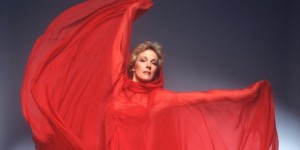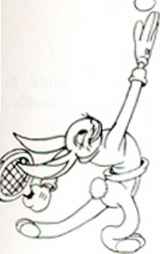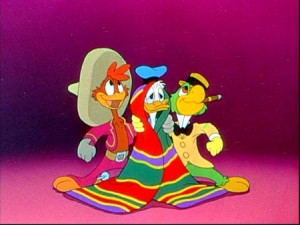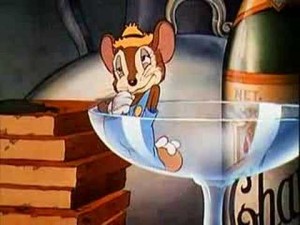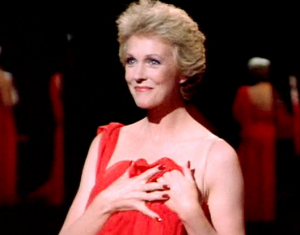From The Soho News (July 8, 1981). From today’s vantage point (fall 2016), I think I was much too needlessly unkind here to Blake Edwards, not to mention Paul Schrader. But I would add that part of my charge against S.O.B. would apply equally well to The Player: the alleged hatchet-job is really a celebration, and one that depends on the hypocritical complicity of the viewer. -– J.R.
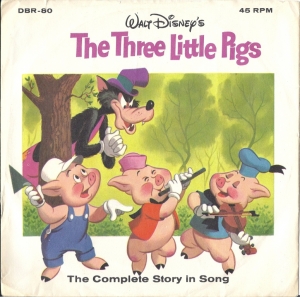
Disney Animation and Animators
Whitney Museum of American Art.
through September 6
S.O.B.
Written and directed by Blake Edwards
Postmodernism is a jive-ass, commercially-minded, art-related movement which seems to be guided by three central tenets or market strategies” (1) if it works, it’s art; (2) if it fails, it’s politics; (3) if it sells, it works. It also betrays an overall yearning aspiration to reconcile radically opposed positions, like Karl Marx and Ayn Rand. (If you had to boil it down to a single tenet, perhaps this would be Total Gross Precedes Essence, with Existence left out of the formula.)
The spiritual home and stomping ground of postmodernism is Southern California, although a lot of its promotional rhetoric seems to get pumped through New York channels. Its principal aim often appears to be to destroy the individual and combined existential integrity of both art and politics by turning them into the two faces of commerce, this making them “available” (at a price) to everyone. Postmodernism does, indeed, make a great deal possible today, It also makes a great deal literally unthinkable — – which sometimes gives me the creeps.
To get the full measure of what Disney Animation and Animators — an imposing array of artifacts occupying the entire second floor at the Whitney through September 6 – really means and is, one has to consider a three-way cultural merger taking place. The crucial mediating, postmodernist role is performed by Site, the flashy architectural, environmental arts organization that has installed the show at the Whitney with real imagination and flair — smoothly presiding (if not actually officiating) over this benign marriage of corporate monsters. Whitney Sites Disney, one is tempted to say, but also Disney Sites Whitney: two formerly unaffiliated body-snatchers, factory and museum, invade, consume, and exploit one another for mutual profit.
Another three-way merger is taking place at the Whitnev between film, video, and gallery space – an intricate encounter of collaborations, accommodations, and compromises. The films, adding up to 21 separate programs that are mainly designated by the useful analytical categories coined by guest curator Greg Ford — ranging from “Discovery of Personality” in the fourth to “Nature: The Four Elements” in the eighth to “Star Vehicles” (tenth), “Wartime Cartoons” (eleventh), “Mood Musicals” (seventeenth), “Animal Movement” (nineteenth), and “Transfigurations” (twenty-first) – will be shown in the afternoons in the Whitney’s cramped, uncomfortable auditorium, unfortunately one of the worst places to see movies in Manhattan.
More elastically, you can take the alternate route of following the steps of Disney animation and animators at your leisure, in a more localized and fragmentary manner – the basic idea of the remainder of the show, implemented and effected in a number of ingenious ways. (Many ofthese, one should note, have been on evidence in an independent, non-Disney context since the beginning of this year, at the enterprising Animators’ Gallery at 484 Broome Street’) Animation sketches and drawings of various kinds, along with fully colored cels and backgrounds, are hung within the 40 or so 12 x 8 frames used to contain most of the exhibits. These are separately lit, surrounded by black walls and simulated movie-theater darkness, animated (with or without sound or color) on nearby video screens, and used to illustrate some of Ford’s analytical categories and the individual contributions of many of the most celebrated Disney animators.
In the first room of the show, for instance, entitled “Early Motion Ideas,” Site project director Theodore Adamstein has individually “boxed” and framed 44 separate pencil drawings by Ham Luske of a hare with a tennis racket, circa 1938, 11 across and four down, next to a video screen that presents an animated version of this “action analysis” first in pencil, then (with many more individual frames) in full color. Only when the illusion is totally assembled do we get to see the busy, Borg-like rabbit playing tennis with himself, on both sides of the set, for the benefit of four adoring female bunny spectators.
Much further on, in the extended section devoted to the famous “Nine Old Men” of the Disney Studio — for me, the most stylistically informative part of the show –one sees about 20 out of 90 drawings by Ward Kimball for one rapid, brilliant snatch of The Three Caballeros (1945), done to register an incredible flurry of frantic activity during the few privileged seconds it takes the title feathery leads to chirp, “Each man is for himself.” It’s an ironic declaration to come across in this ambiguous context, which highlights the individual contribution to the corporate entity (the Disney movie) at the same time it honors the process that grinds that contribution into Corn Flakes. I’m talking about the patriarchal authority of the dollar represented by good ole Uncle Scrooge/Walt, whose office’s globe of the world was as cosmically meaningful as the one belonging to Chaplin’s Great Dictator – the man who colonized, pooled, homogenized, and exploited all those diverse, individual talents. (As an organizer of collective style, he was comparable to Henry Ford and John Ford, not to mention Luce and Hefner.)
It’s curious to reflect on the process by which Disney has gone from being a high art culture hero in the 30s (with a personality cult as popular, in a way, as that of his Nazi pal and stylistic soulmate Leni Riefenstahl) to a kitschy shlockmeister at mid-century to yet another gilt-edged cultural item in the 80s. In 1930, Eisenstein called him the most interesting filmmaker in America. Some 38 years later, in The Disney Version, Richard Schickel directly implied that “he had no more artistic conscience and intelligence than a kumquat.”The last time I was in Disneyland, four summers ago, I came upon a pricey little shop on Main Street, USA that sold Disney memorabilia -– a place that literally priced into collectors’ itemsthe cheap merchandise it bought back, through a giddy recycling process that I’m sure any postmodernist could appreciate.
“Gee, this’ll make Beethoven!” Disney reportedly remarked after looking at a sequence in Fantasia. Discovering, in the Whitney show, that the wonderfully disassembled Goofy Walk (in Moving Day, 1936) can be ascribed to Art Babbitt -– whose “drunk but graceful Country Mouse” (The Country Cousin, 1936), enraged wicked queen (Snow White and the Seven Dwarfs, 1938), and gentle inquiring Geppetto (saying “No?” in four drawings from the 194o Pinocchio) are all visible in the same 12 x 8 module –- it was certainly possible to speculatethat “this made Goofy”. But there isn’t anything at the show that could begin to help me understand what Disney (and Babbitt, for that matter) did to mass-produce me a kid. All I get, really, is what Disney did to, for, and because of his talented employees.
One thing that’s theoretically challenging – as well as provocative and absorbing – about the show is the way that it offers a kind of auteurist rundown of a twentieth century equivalent to Chartres; an art object (namely the Disney Empire) that somehow combines and reconciles Manny Farber’s dialecticaldegories of White Eleplant Art and Termite Art, the monumental and pretentious yersus the throwaway and anonymous.
Indeed, one could argue that auteurism itself, by exalting individuality and personal style in and through the machinations of the Hollywood sausage factory (which it also exalts), officiates at this postmodernist recycling process that strives to keep art as “spanking new” as a polished Disney cartoon bottom — waiting eagerly to be swiftly booted into yet another capitalist spinoff enterprise. (If Donald Duck can be a fruit drink or a salt shaker, runs the argument, why can’t he be an art object, too?)
But the Three Little Pigs of art history, architecture, and film –-a trio of embattled interests in the Reagan economy that is fast becoming beseiged (according to my cartoon, anyway) by the Big Bad Wolf of postmodernism, huffing and puffing and blowing down every ethically divisionary shelter in sight – still hasn’t been processed into the yummy pork-on-a-stick that Disney Animations and Animators as a corporate entity apparently aims for. And I’m, inclined to feel somewhat grateful for this.
Come to think of it, the idea of wild pigs running (or mice cavorting) through a museum does make it all seem pretty attractive. Postmodernists know plenty about making the appearance (as opposed to the fact) of subversion attractive: see A Thousand Clowns, Norma Rae, Lina Wertmuller, Werner Herzog, La Cage aux folles, S.O.B. The Whitney show deconstructs the illusionistprocesses of animationbeautifully, but leaves the crushing dominance of the Disney myth intact.
***
If S.O.B. deconstructs anything, it’s the credulity of some critics. Assuming that American auteurism still has a few things to answer for, the overestimation of Blake Edwards (and corresponding neglect of Frank Tashlin) as a trenchant social satirist conceivably belongs somewhere toward the top of the list. A laid-lack status quo director with some flair for visual gags (the Perry Como of slapstick) streaked with Hefner-style eroticism, Edwards — who seems to fancy cute asses almost as much as Disney did – simply doesn’t have the makings of the cinematic Voltaire or Brecht that some of his postmodernist admirers want to find in his sudsy entertainments. His best comedy, The Party, has always seemed to me a little bit like a softer Playtime for squares — literally, those intelligences locked exclusively into box-like comic patterns that depend on center-framing and unsyncopated box-step timing.
To believe the advance reports that Edwards’ S.O.B. is a scathing, bitter indictment of Hollywood makes about as much sense as expecting Paul Schrader to make a feminist movie campaigning for better race relations and unions, less persecution of gays, and tighter gun controls. Would one expect a talented cocktail pianist to “bitterly indict” his own instrument through his music? If he did such a thing, would we still call him a cocktail pianist?
Fearful Edwards fans may rest assured: the writer-director may have been in temporary physical and/or spiritual exile from Hollywood when he first scripted S.O.B. in the early 70s, but the slick complacency of his Hollywood manner survives with scarcely a wrinkle. The press book refers to his “love-hate relationship to the film industry,” but it’s precisely the absence of love or hatred, for anything or anyone in this movie, that keeps it all comfortably tepid about its own apparent hysteria.
Toward the end of the film, I thought I detected some genuine (if sentimental) affection for a trio of drunken middle-aged louts –- director William Holden, doctor Robert Preston, and press agent Robert Webber, all spiritual cousins of Dudley Moore in 10 — kidnapping the corpse of their producer pal (Richard Mulligan) to give him a “proper” Viking funeral in Malibu, out on an all-night spree like refugees from a Cassavetes film or a Gene Fowler gossip book. But as a friend pointed out to me, even this rare show of feeling is cynically protected by the phony song being sung by the producer’s widow (Julie Andrews) at the hypocritical “official” funeral attended by all the cartoonish villains in the cast –- a song which is allowed to ride roughshod over the crosscutting between respective funerals like syrup over pancakes.
If S.O.B. seems ultimately dishonest about its portrait of Hollywood as heartless, decadent, and money-mad, this is partially because it doesn’t hesitate to let the audience off the hook in relation to these matters every chance that it gets. The perfunctory process by which the world’s all-time biggest flop gets magically transformed into the world’s all-time top grosser just because Julie Andrews flashes a little bare tit is neither an insult to the audience nor a tribute –- simply a labored come-on and plot mechanism. The same could be said for the strident overplaying in Mulligan’s spectacularly unfunny performance as the frantic producer, which tries to make up in intensity for what it lacks in imagination or wit.
There are a few graceful and funny moments in S.O.B. (which stands for Standard Operational Bullshit — I’m tempted to call it S.O.P. instead, for Same Old Punchlines). There’s even one beautiful moment, a sight gag in which Mulligan, between suicide attempts, steps on a rug previously thrown over a hole in the second floor of his Malibu house, and literally floats down into the orgy taking place in his living room. (This is supposed to be an indictment of Hollywood? Come on, fellas.)
There’s some forced but conceptually interesting stuff about a Hollywood actor with a dog, who dies nearby on the beach, becoming a body which everyone ignores, and which eventually winds up in the producer’s coffin — sort of a Babytown version of The Unknown Soldier, I suppose, but at least it’s weird. The audible farting and pissing and inaudible vomiting and shitting of the press agent, intermittently introduced to liven things up (perhaps with intimations of mortality and related Malibu deepthink), made me long for the more honest vulgarity of a Mel Brooks, Bob Fosse, or Ken Russell (to cite three more Musical Comedy Death specialists). By contrast, Edwards’ tasteless handling of stereotypical Mexican and Chinese servants doesn’t even have the excuse of being funny.
But I loved the good-natured sermon delivered by an Indian guru (Larry Storch) at the “official” funeral held on the same studio soundstage where the widow formerly went from G to X — a very obliging postmodernist holy man, San Diego to the core, who cites the latest box-office receipts and projected grosses of the deceased’s last hit, as reported in Variety, and then goes on to cite portions of his beloved filmography: Love on a Pogo Stick, Torn Man from Tennessee, Invasion of the Pickle People, Odyssey of Pain.
Thinking back on this funny kook, I realize that his toothy smile and flowing white beard function as effectively as the movie-house black that surrounds all the exhibition in the Disney show — a parade of floating objects and characters that reverentially includes not only portions of filmography but fragments of film, too. But in the long stretch, S.O.B. is a lot of, conspicuous consumption parading as satire. (Check out Chaplin’s A King in New York for some honest bile, if that’s what you want.) For art and politics, go see Numéro Deux or Cutter’s Way. For the two faces of postmodernist commerce, Disney at the Whitney and Edwards-by-the-sea provide much safer bets. Admittedly, both are infantile, but I vastly prefer the former; as Variety puts it, it has legs.

